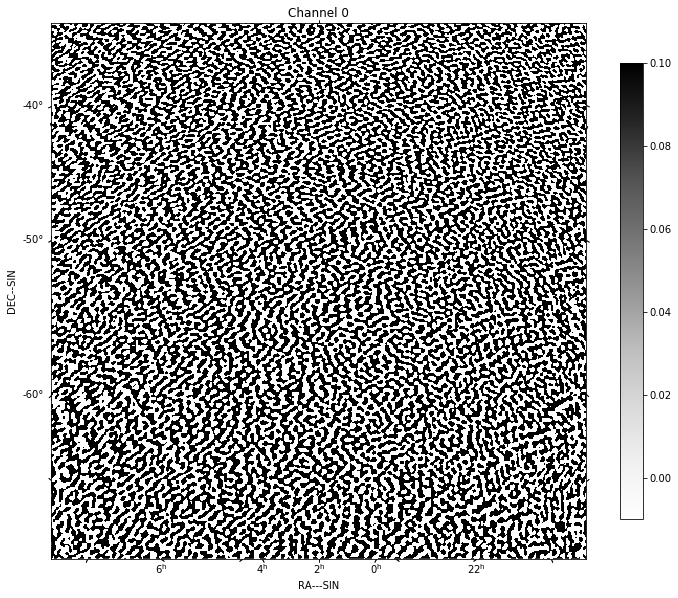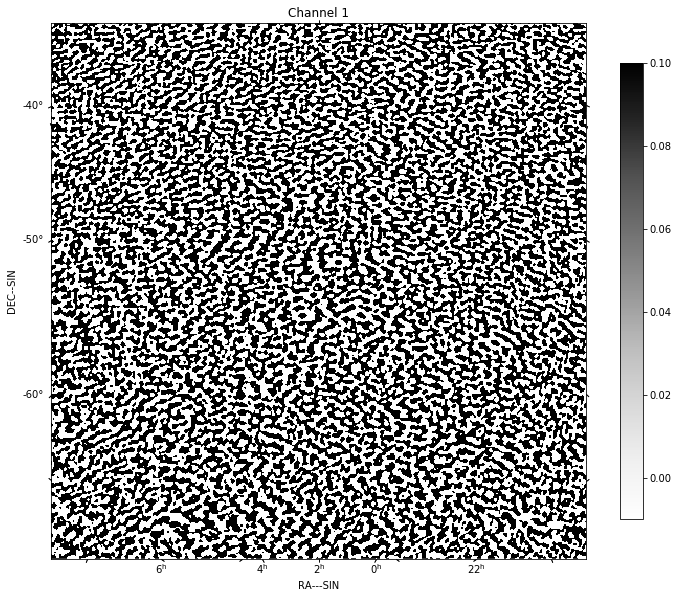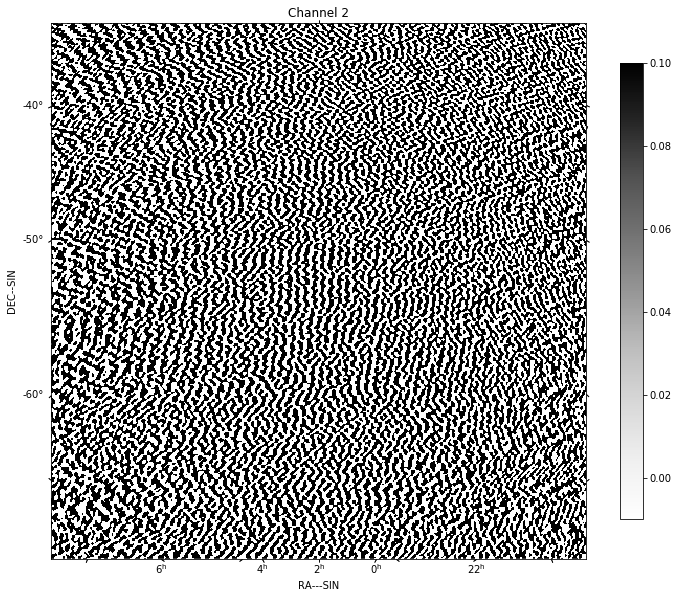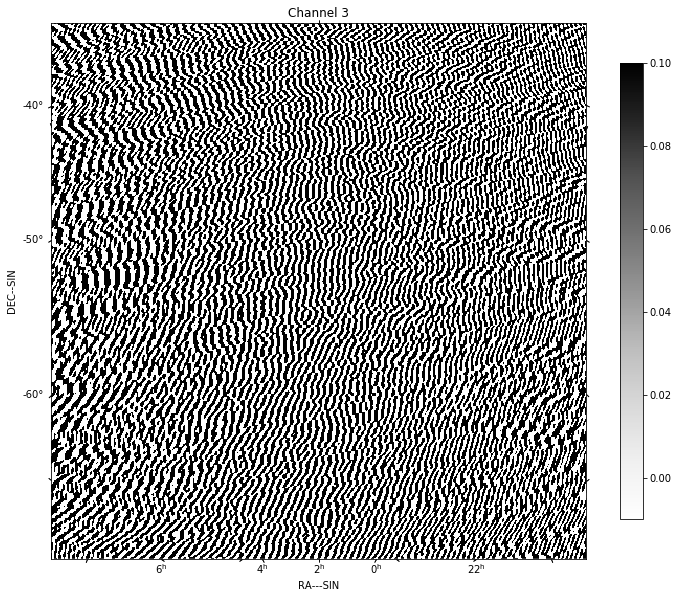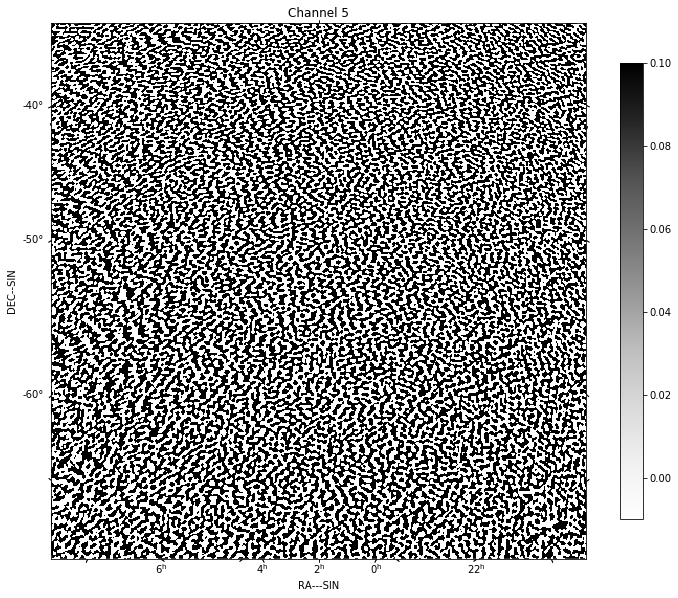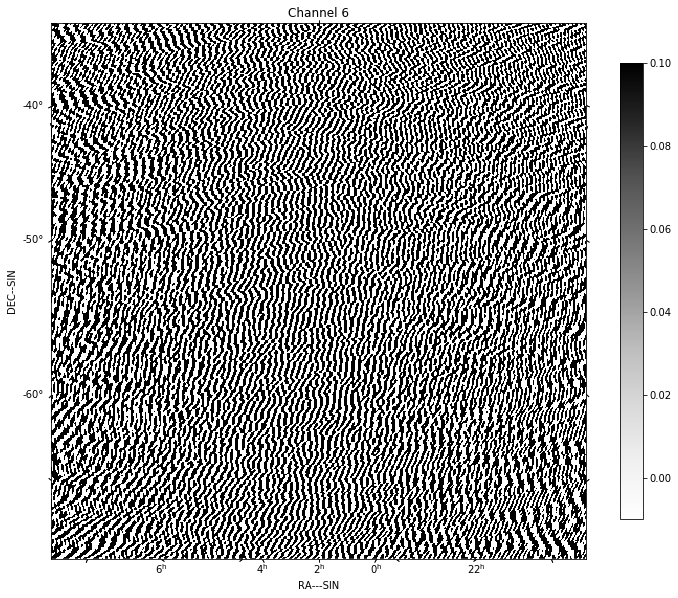Pipeline processing using arlexecute workflows.¶
This notebook demonstrates the continuum imaging and ICAL pipelines. These are based on ARL functions wrapped up as SDP workflows using the arlexecute class.
%matplotlib inline
import os
import sys
sys.path.append(os.path.join('..', '..'))
from data_models.parameters import arl_path
results_dir = arl_path('test_results')
from matplotlib import pylab
pylab.rcParams['figure.figsize'] = (12.0, 12.0)
pylab.rcParams['image.cmap'] = 'rainbow'
import numpy
from astropy.coordinates import SkyCoord
from astropy import units as u
from astropy.wcs.utils import pixel_to_skycoord
from matplotlib import pyplot as plt
from data_models.polarisation import PolarisationFrame
from processing_components.calibration.calibration import solve_gaintable
from processing_components.calibration import apply_gaintable
from processing_components.calibration.calibration_control import create_calibration_controls
from processing_components.visibility import create_blockvisibility
from processing_components.skycomponent import create_skycomponent
from processing_components.image import deconvolve_cube
from processing_components.image import show_image, export_image_to_fits, qa_image
from processing_components.visibility import vis_timeslice_iter
from processing_components.simulation.testing_support import create_low_test_image_from_gleam
from processing_components.simulation.configurations import create_named_configuration
from processing_components.imaging import predict_2d, create_image_from_visibility, advise_wide_field
from processing_components.visibility import convert_blockvisibility_to_visibility
from workflows.arlexecute.imaging.imaging_arlexecute import invert_list_arlexecute_workflow, \
predict_list_arlexecute_workflow, deconvolve_list_arlexecute_workflow
from workflows.arlexecute.simulation.simulation_arlexecute import simulate_list_arlexecute_workflow, \
corrupt_list_arlexecute_workflow
from workflows.arlexecute.pipelines.pipeline_arlexecute import continuum_imaging_list_arlexecute_workflow, \
ical_list_arlexecute_workflow
from wrappers.arlexecute.execution_support.arlexecute import arlexecute
import pprint
pp = pprint.PrettyPrinter()
import logging
def init_logging():
log = logging.getLogger()
logging.basicConfig(filename='%s/imaging-pipeline.log' % results_dir,
filemode='a',
format='%(asctime)s,%(msecs)d %(name)s %(levelname)s %(message)s',
datefmt='%H:%M:%S',
level=logging.INFO)
log = logging.getLogger()
logging.info("Starting imaging-pipeline")
We will use dask
arlexecute.set_client(use_dask=True)
arlexecute.run(init_logging)
/home/jenkins-slave/workspace/ce-library_feature-improved-docs/_build/lib/python3.5/site-packages/distributed/dashboard/core.py:72: UserWarning:
Port 8787 is already in use.
Perhaps you already have a cluster running?
Hosting the diagnostics dashboard on a random port instead.
warnings.warn("n" + msg)
{'tcp://127.0.0.1:36259': None,
'tcp://127.0.0.1:42581': None,
'tcp://127.0.0.1:43559': None,
'tcp://127.0.0.1:45117': None}
pylab.rcParams['figure.figsize'] = (12.0, 12.0)
pylab.rcParams['image.cmap'] = 'Greys'
We create a graph to make the visibility. The parameter rmax determines the distance of the furthest antenna/stations used. All over parameters are determined from this number.
nfreqwin=7
ntimes=5
rmax=300.0
frequency=numpy.linspace(1e8,1.2e8,nfreqwin)
channel_bandwidth=numpy.array(nfreqwin*[frequency[1]-frequency[0]])
times = numpy.linspace(-numpy.pi/3.0, numpy.pi/3.0, ntimes)
phasecentre=SkyCoord(ra=+30.0 * u.deg, dec=-60.0 * u.deg, frame='icrs', equinox='J2000')
bvis_list=simulate_list_arlexecute_workflow('LOWBD2',
frequency=frequency,
channel_bandwidth=channel_bandwidth,
times=times,
phasecentre=phasecentre,
order='frequency',
rmax=rmax, format='blockvis')
vis_list = [arlexecute.execute(convert_blockvisibility_to_visibility)(bv) for bv in bvis_list]
print('%d elements in vis_list' % len(vis_list))
log.info('About to make visibility')
vis_list = arlexecute.compute(vis_list, sync=True)
7 elements in vis_list
wprojection_planes=1
advice_low=advise_wide_field(vis_list[0], guard_band_image=8.0, delA=0.02,
wprojection_planes=wprojection_planes)
advice_high=advise_wide_field(vis_list[-1], guard_band_image=8.0, delA=0.02,
wprojection_planes=wprojection_planes)
vis_slices = advice_low['vis_slices']
npixel=advice_high['npixels2']
cellsize=min(advice_low['cellsize'], advice_high['cellsize'])
Now make a graph to fill with a model drawn from GLEAM
gleam_model = [arlexecute.execute(create_low_test_image_from_gleam)(npixel=npixel,
frequency=[frequency[f]],
channel_bandwidth=[channel_bandwidth[f]],
cellsize=cellsize,
phasecentre=phasecentre,
polarisation_frame=PolarisationFrame("stokesI"),
flux_limit=1.0,
applybeam=True)
for f, freq in enumerate(frequency)]
log.info('About to make GLEAM model')
gleam_model = arlexecute.compute(gleam_model, sync=True)
future_gleam_model = arlexecute.scatter(gleam_model)
log.info('About to run predict to get predicted visibility')
future_vis_graph = arlexecute.scatter(vis_list)
predicted_vislist = predict_list_arlexecute_workflow(future_vis_graph, gleam_model,
context='wstack', vis_slices=vis_slices)
predicted_vislist = arlexecute.compute(predicted_vislist, sync=True)
corrupted_vislist = corrupt_list_arlexecute_workflow(predicted_vislist, phase_error=1.0)
log.info('About to run corrupt to get corrupted visibility')
corrupted_vislist = arlexecute.compute(corrupted_vislist, sync=True)
future_predicted_vislist=arlexecute.scatter(predicted_vislist)
/home/jenkins-slave/workspace/ce-library_feature-improved-docs/_build/lib/python3.5/site-packages/distributed/worker.py:3235: UserWarning: Large object of size 2.10 MB detected in task graph:
('getitem-935182402f32bdac003d4310332f841e', <data ... -065562ba0441')
Consider scattering large objects ahead of time
with client.scatter to reduce scheduler burden and
keep data on workers
future = client.submit(func, big_data) # bad
big_future = client.scatter(big_data) # good
future = client.submit(func, big_future) # good
% (format_bytes(len(b)), s)
Get the LSM. This is currently blank.
model_list = [arlexecute.execute(create_image_from_visibility)(vis_list[f],
npixel=npixel,
frequency=[frequency[f]],
channel_bandwidth=[channel_bandwidth[f]],
cellsize=cellsize,
phasecentre=phasecentre,
polarisation_frame=PolarisationFrame("stokesI"))
for f, freq in enumerate(frequency)]
dirty_list = invert_list_arlexecute_workflow(future_predicted_vislist, model_list,
context='wstack',
vis_slices=vis_slices, dopsf=False)
psf_list = invert_list_arlexecute_workflow(future_predicted_vislist, model_list,
context='wstack',
vis_slices=vis_slices, dopsf=True)
Create and execute graphs to make the dirty image and PSF
log.info('About to run invert to get dirty image')
dirty_list = arlexecute.compute(dirty_list, sync=True)
dirty = dirty_list[0][0]
show_image(dirty, cm='Greys', vmax=1.0, vmin=-0.1)
plt.show()
log.info('About to run invert to get PSF')
psf_list = arlexecute.compute(psf_list, sync=True)
psf = psf_list[0][0]
show_image(psf, cm='Greys', vmax=0.1, vmin=-0.01)
plt.show()
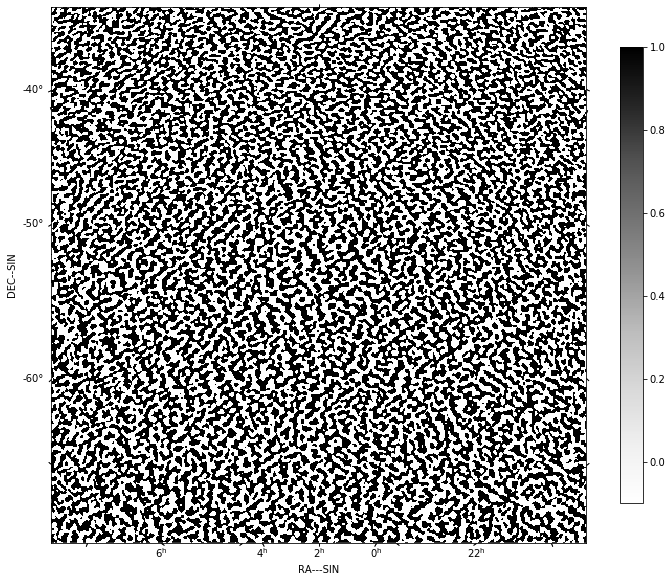
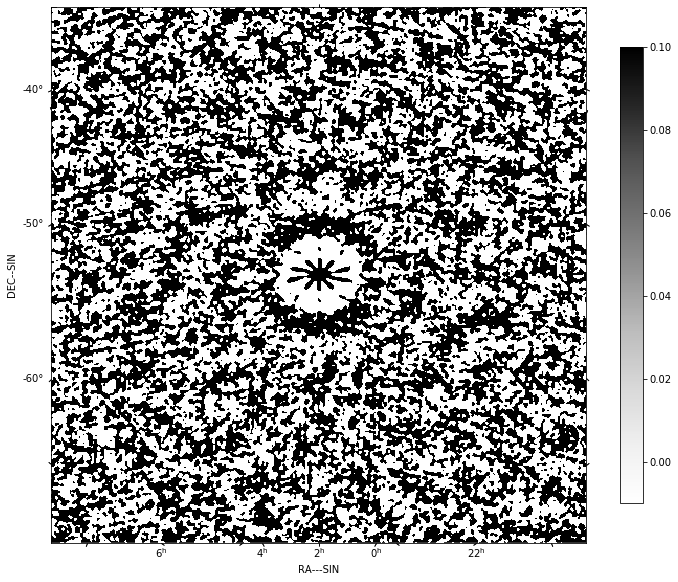
Now deconvolve using msclean
log.info('About to run deconvolve')
deconvolve_list = \
deconvolve_list_arlexecute_workflow(dirty_list, psf_list, model_imagelist=model_list,
deconvolve_facets=8, deconvolve_overlap=16, deconvolve_taper='tukey',
scales=[0, 3, 10],
algorithm='msclean', niter=1000,
fractional_threshold=0.1,
threshold=0.1, gain=0.1, psf_support=64)
centre=nfreqwin // 2
deconvolved = arlexecute.compute(deconvolve_list, sync=True)
show_image(deconvolved[centre], cm='Greys', vmax=0.1, vmin=-0.01)
plt.show()
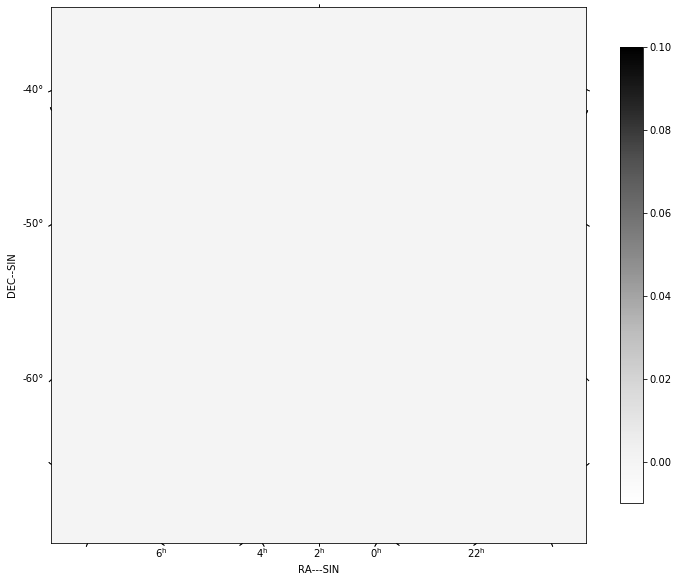
continuum_imaging_list = \
continuum_imaging_list_arlexecute_workflow(future_predicted_vislist,
model_imagelist=model_list,
context='wstack', vis_slices=vis_slices,
scales=[0, 3, 10], algorithm='mmclean',
nmoment=3, niter=1000,
fractional_threshold=0.1,
threshold=0.1, nmajor=5, gain=0.25,
deconvolve_facets = 8, deconvolve_overlap=16,
deconvolve_taper='tukey', psf_support=64)
log.info('About to run continuum imaging')
centre=nfreqwin // 2
continuum_imaging_list=arlexecute.compute(continuum_imaging_list, sync=True)
deconvolved = continuum_imaging_list[0][centre]
residual = continuum_imaging_list[1][centre]
restored = continuum_imaging_list[2][centre]
f=show_image(deconvolved, title='Clean image - no selfcal', cm='Greys',
vmax=0.1, vmin=-0.01)
print(qa_image(deconvolved, context='Clean image - no selfcal'))
plt.show()
f=show_image(restored, title='Restored clean image - no selfcal',
cm='Greys', vmax=1.0, vmin=-0.1)
print(qa_image(restored, context='Restored clean image - no selfcal'))
plt.show()
export_image_to_fits(restored, '%s/imaging-dask_continuum_imaging_restored.fits'
%(results_dir))
f=show_image(residual[0], title='Residual clean image - no selfcal', cm='Greys',
vmax=0.1, vmin=-0.01)
print(qa_image(residual[0], context='Residual clean image - no selfcal'))
plt.show()
export_image_to_fits(residual[0], '%s/imaging-dask_continuum_imaging_residual.fits'
%(results_dir))
Quality assessment:
Origin: qa_image
Context: Clean image - no selfcal
Data:
medianabs: '0.0'
rms: '0.0'
medianabsdevmedian: '0.0'
max: '0.0'
median: '0.0'
min: '0.0'
shape: '(1, 1, 512, 512)'
maxabs: '0.0'
sum: '0.0'
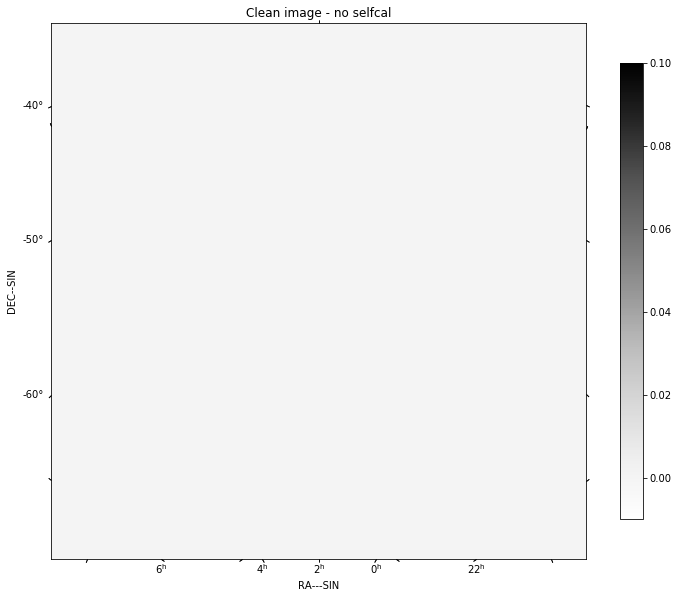
Quality assessment:
Origin: qa_image
Context: Restored clean image - no selfcal
Data:
medianabs: '688.3502286271572'
rms: '1021.4802532776182'
medianabsdevmedian: '688.4680676287186'
max: '5117.058033205791'
median: '-1.449663691750892'
min: '-5167.827903218968'
shape: '(1, 1, 512, 512)'
maxabs: '5167.827903218968'
sum: '28288.07939484644'

Quality assessment:
Origin: qa_image
Context: Residual clean image - no selfcal
Data:
medianabs: '688.3502286271572'
rms: '1021.4802532776182'
medianabsdevmedian: '688.4680676287186'
max: '5117.058033205791'
median: '-1.449663691750892'
min: '-5167.827903218968'
shape: '(1, 1, 512, 512)'
maxabs: '5167.827903218968'
sum: '28288.07939484644'
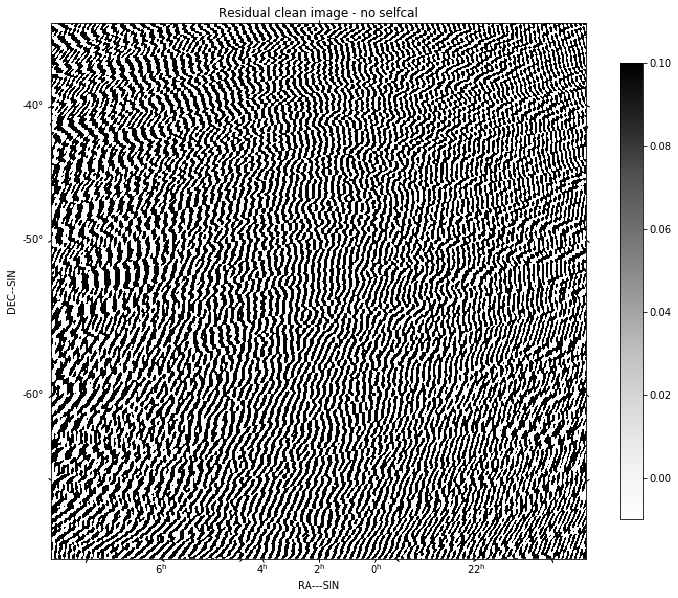
for chan in range(nfreqwin):
residual = continuum_imaging_list[1][chan]
show_image(residual[0], title='Channel %d' % chan, cm='Greys',
vmax=0.1, vmin=-0.01)
plt.show()
